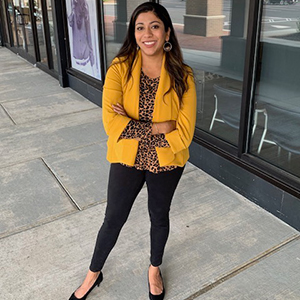| | 
| | Jennifer Tsai, OD.
| |
ECPs Weigh In on the Growing Need for Sustainability in Eyecare
For Jennifer Tsai, OD, owner and founder of Line of Sight in New York, sustainability is all about “minimizing environmental impact as a retail practice while still prioritizing patient ocular health.” For Dr. Tsai and her staff, this means implementing energy-saving measures like LED lighting, using washable drinking cups instead of plastic bottles, recycling materials, cutting down on all forms of paper, purchasing from sustainable companies and partnering with eyecare recycling programs.
Dr. Tsai has also noticed a growing interest in sustainability from her patients, who have started shopping around to find both the products and the providers who are willing to implement sustainability initiatives in their practices.
“I’ve noticed that patients are becoming more informed and conscious consumers, and they are starting to prioritize sustainability when making decisions about their eyecare products and even providers,” Dr. Tsai said. “Our patients are more willing to participate in recycling their contact lens waste and used eyewear frames and bringing them to drop off at our practice.”
She also noted the eyecare industry has moved more in the direction of sustainability. “There's definitely been a growing awareness of sustainability within the eyecare industry in recent years. Eyewear brands are responding to this by using more sustainable materials in their frames and packaging, in addition to environmentally friendly manufacturing processes. Contact lens companies have initiated recycling programs for used contact lenses, cases, bottles and packaging materials.”
Climate change is an area where Dr. Tsai believes sustainability plays an important role in combating related eye conditions. She noted that climate change can impact eye health by worsening conditions like dry eye syndrome and allergic conjunctivitis, due to changes in temperature and pollen distribution. She also warned that increased UV radiation from climate change can potentially lead to concerns like macular degeneration and cataract formation.
Finally, she said, extreme weather events can cause physical eye injuries, corneal abrasions, and changing disease patterns may affect eye health.
“Climate change is a high priority for our interest in sustainability initiatives due to the understanding that it can exacerbate eye and health conditions, such as dry eyes, contact lens discomfort and ocular allergies. Overall, climate change sustainability efforts help us engage with our local community as well as support each other in the neighborhood.”
| |  | | | Rasika Whitesell, OD. |
Catering to Patients’ Sustainability Needs
Rasika Whitesell, OD, owner of Port City Optometry in Wilmington, N.C., has seen her patients’ interest in sustainability products and the health of the environment heighten since she opened her doors about a year ago.
“I think people are much more aware of what they are putting into the environment. There is so much research about how humans are impacting the earth and the environment. Larger corporations are, thankfully, becoming more involved and speaking out. Companies are actively taking steps to reduce their carbon footprint, such as car manufacturers, the beauty industry and an increase of measures in the eyecare world. This has really helped spread awareness of environmental issues.”
Dr. Whitesell noted that the most common question she gets from patients about sustainable eyecare products pertains to daily contact lenses.
“Daily contact lenses are on the rise in our patients because doctors know they are healthier, more comfortable, and have the lowest risk of infection. When I mention to the patient that we should try daily contact lenses, many times they say ‘that seems wasteful.’ They are worried about the extra packaging and plastic that is being used and tossed away daily,” she said.
“What I tell patients is that most contact lens companies are now making sure the plastic they use is recyclable. I also tell them that if they were in a monthly contact lens that they would still need plastic contact lens cases and at least two bottles of contact lens solution per month. The amount of plastic that it takes to make those products also adds up to nearly the same as the amount of daily contact lens package waste.”
For Whitesell, whose practice provides care for patients with cataracts, dry eye, glaucoma, macular degeneration, and other eye conditions caused by systemic diseases, the opportunity to reuse and recycle is something she values in her new practice.
“I do not believe in wasting anything. I try to purchase/invest in items that can be reused, repurposed or donated. When I opened my practice one year ago, I really wanted mostly everything to be digital. I don’t use much paper in the office,” she said. “Patients love the digital aspect. Patients also love that they can bring their older pairs of glasses to donate. We send all gently used glasses to the Lions Club. In turn, they will take them on mission trips and/or donate [the eyeglasses] to anyone in need.
“Energy efficiency is also key. Thankfully, in optometry we don't have to use bright overhead lighting. We do have to use a lamp and some equipment does involve bulbs. We try to use LED-efficient bulbs whenever possible. We also try to do all electronic billing to patients through email or text and we rarely send out a paper bill anymore or even a reminder postcard. We thankfully live in a digital world that most people have embraced.”
Climate change is another area that can affect the ocular health of patients and presents another opportunity for sustainability initiatives to take hold both at home and in businesses.
“Environmental changes such as humidity, temperature and air quality can have a big impact on ocular health,” Whitesell said. If air quality is reduced, this can increase allergens and pollutants in the air. This would impact the eyes causing dryness, irritation and redness.
“The other concern with climate change is ozone depletion and the decrease of UV protection of our earth; this can negatively impact humans. The eyes, especially, are very sensitive to a higher UV index. Cataracts, pterygium and eye cancers can increase dramatically with an increase in prolonged UV exposure. Rising temperatures, which has also been attributed to climate change, will also lead to dehydration which can result in severe dry eyes.
“Overall, we each have to make small changes in how we run our homes and our businesses. This can collectively lead to a positive impact on the environment and keep our earth sustainable for many more years,” Dr. Whitesell concluded.
 |
| | Frances Bynum, OD. |
|
Educating Patients on Sustainability
Sustainability may not be top of mind for most of the patients that walk through the door of Northwest Tennessee Eye Clinic in Martin and Greenfield, Tenn., a provider of vision care products and services in the area. But that hasn’t prevented owner Frances Bynum, OD, from letting them know that her practice takes the topic of sustainability seriously.
“I do believe that there is more awareness about sustainability, and I think patients expect companies to be mindful of our world and its resources,” Dr. Bynum said. “But patients rarely ask about sustainability. However, I like to take time to tell patients that we like to do business with companies that are forward thinking about sustainability. We like to think of it as a partnership.”
According to Dr. Bynum, she is choosing to partner with companies that have sustainability plans. “As an eyecare provider, I am responsible for my patients, staff and my family. If I can choose to partner with companies that find value in helping our environment and develop processes that use renewable resources, recycle, use resources more efficiently or create less pollution, then we can preserve the environment for future generations.”
Climate change is among the factors that drive Dr. Bynum and her staff in their sustainability efforts, but it isn’t the chief motivation.
“I would not say climate change is my motivation. My motivation is to be responsible for what I can control,” she said. “That is doing little things like recycling all the cardboard, paper and plastic. Unfortunately, we do not have ‘recycling pickup’ where I live, therefore, I have to take recycling to the local recycling center. Also, be mindful of water, electricity and other resources that we must use in our practice.”
She continued, “There are many ways that climate changes affect eye health. Increased UV rays (from loss of ozone) can increase conditions like cataracts, pterygium and possible retinal issues. Extreme weather events such as wildfires can put harmful irritants in the atmosphere. Decreasing rain forests and increased deserts, which have arid conditions, increase dry eyes (ocular surface disease).
“We do not know the long-term effects of climate change on the eye and overall health factors associated with long-term changes, but we should be mindful of these conditions that are affected by short-term events and be prepared to diagnose, treat and monitor.” | |